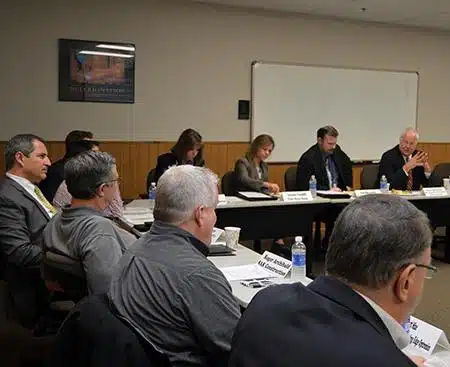
O’Fallon Casting offers Investment Casting-101 classes to its customers to help educate their Engineers on the Fundamentals of Investment Casting design. More than twenty “IC-101” classes were held at customer sites in 2012. IC-101 is intentionally non-promotional and taught in a classroom environment from an industry prospective.
A typical IC-101 class begins with an in-depth review of how an Investment Casting is manufactured, providing a foundation for the more technical discussion that follows. Once these fundamentals are taught, the Advantages & Disadvantages of the process are discussed at length, so that students may grasp how Investment Casting fits with their needs, and also if Investment Casting might offer a better option relative to alternative processes.
For example, one of the advantages of Investment Casting is that it can produce complex configurations with high accuracy. This capability presents Engineering an opportunity to design one-piece castings instead multi-piece fabrications (assemblies, weldments or dip-brazings). A one-piece casting can provide a more rigid and lightweight structure that eliminates assembly time and also the many “soft” costs associated with procurements of multiple pieces.
The second phase of an IC-101 class is a review of Drawing Notes and Specification requirements, and commences with a discussion of minimum information that needs to flow to a foundry by a customer. This is followed by a review of an actual customer drawing, and accessing the adequacy of the notes and the cost of “overkill”. Following the Drawing Note discussion, an in-depth review of Material and NDT Specifications is conducted again identifying their cost implications and noting any “hidden” requirements.
For Example, unless otherwise overwritten by a drawing, some commonly employed specification, such as AMS 4218, require the certification of physical properties be determined from test bars excised from a casting (a relatively expensive method of test that also adds the cost for a destroyed part). When, however, a drawing is employing this material specification also includes a note to determine physical properties from Separately Cast test bars, the recurring cost for physical property testing is significantly reduced.
An IC-101 class concludes with recommendations and detailed discussion of Good Investment Casting Design Practices. Topics covered include: tolerancing, datum selection, datum point placement, fillets & edge radii, etc. Also discussed is the current state of technology in the industry for Rapid Prototypes, Digital Radiography, Non-Contact Metrology, etc.
Students learn, for example, not only the recommended sizes for fillet radii but also explained is why they are necessary to casting production and the cost implications when over/under specified.
A “normal” IC-101 class, allowing for discussion and Q&A, requires approximately three hours. Shorter sessions, of 1 – 2 hours, are conducted for Technical and Administrative staffs to cover the general topics with less specific detail. Each student is given a textbook to be retained for their future reference.
O’Fallon Casting provides IC-101 as a free service to its customers that they might be better users of Investment Castings and to enhance the affordability of their products.
For more information, please see the Investment Casting-101 tab of the O’Fallon Casting website.
